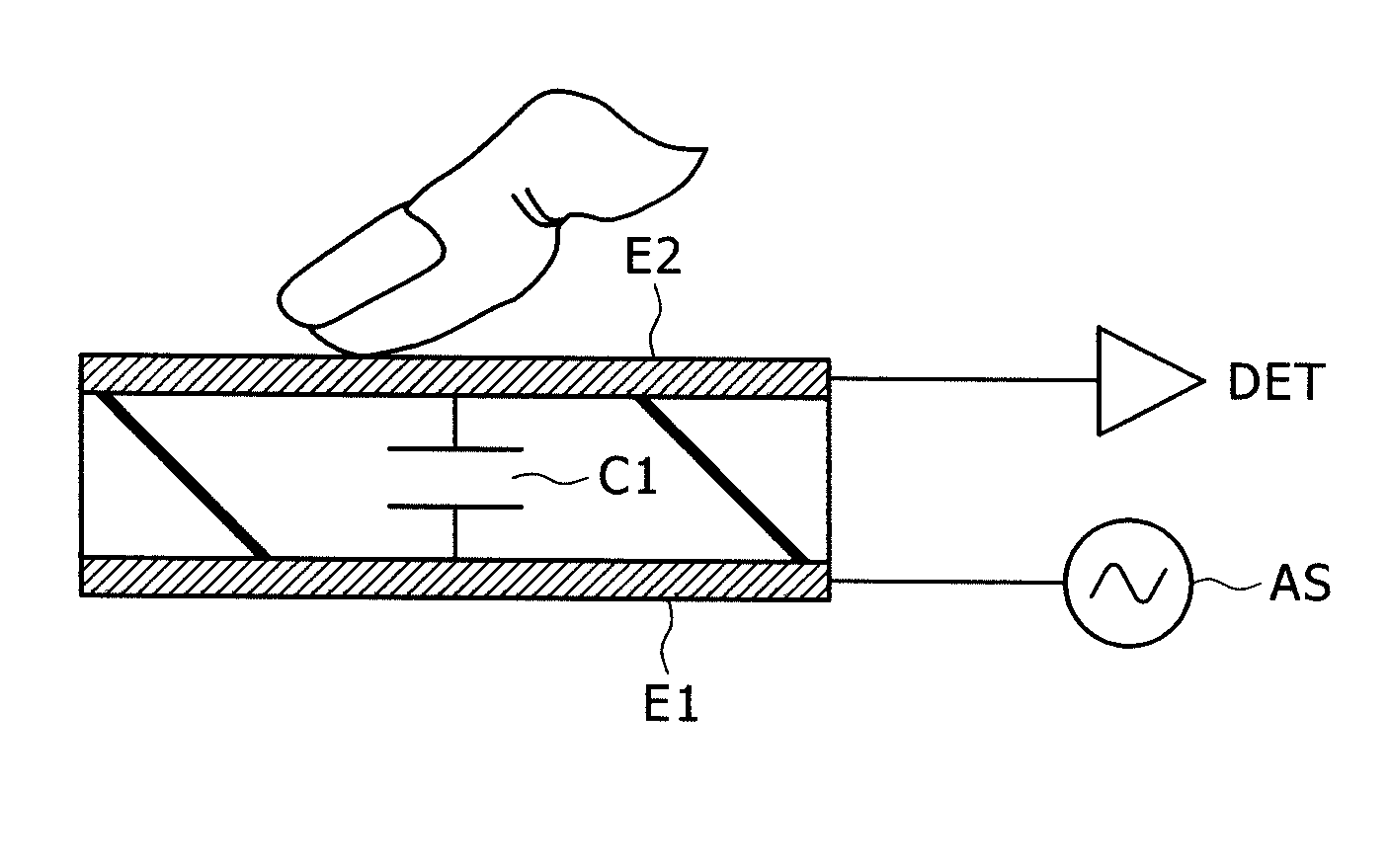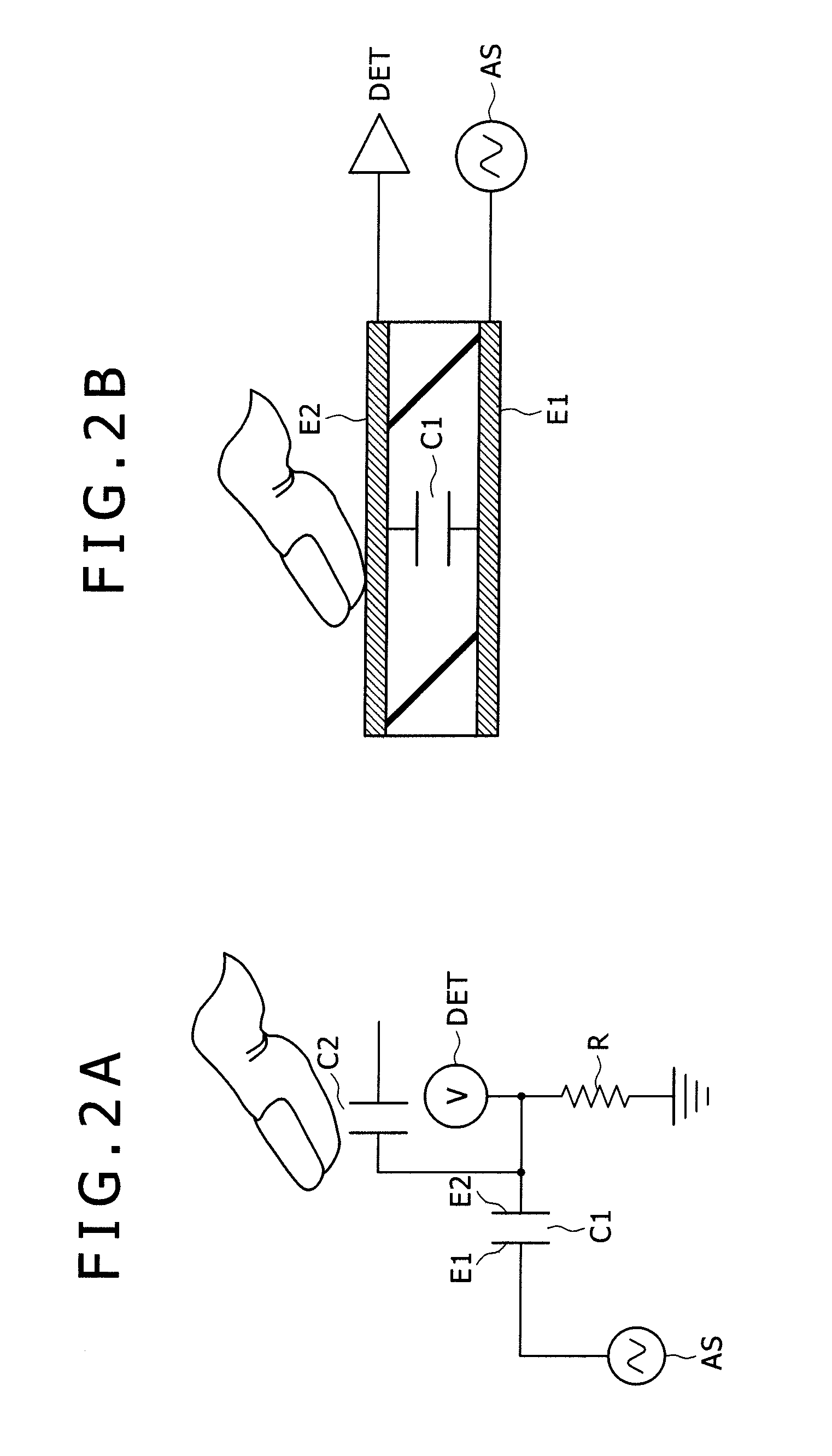Display device and driving method
a technology of a display device and a driving method, applied in the field of display devices and driving methods, can solve the problems of affecting the detection speed of contacts, so as to achieve the effect of minimal latency and high detection speed
- Summary
- Abstract
- Description
- Claims
- Application Information
AI Technical Summary
Benefits of technology
Problems solved by technology
Method used
Image
Examples
first embodiment
1. First Embodiment
Basic Configuration for Contact Detection and Operation
[0043]A description will be given first of the basics of electrostatic capacitance-based contact detection with reference to FIGS. 1A to 3C as a precondition in the first embodiment (condition common to this and other embodiments).
[0044]FIGS. 1A and 2A are equivalent circuit diagrams of a touch sensor section, and FIGS. 1B and 2B structural diagrams (schematic cross-sectional views) of the touch sensor section. Here, FIGS. 1A and 1B illustrate a case in which an object to be detected or a finger is not in proximity to the sensor, and FIGS. 2A and 2B a case in which a finger is in proximity to or contact with the sensor.
[0045]The touch sensor section illustrated in the figures is an electrostatic capacitance touch sensor that includes a capacitive element as illustrated in FIGS. 1B and 2B. More specifically, a capacitive element (electrostatic capacitance) C1 is formed with a dielectric D and a pair of electrod...
second embodiment
2. Second Embodiment
[0102]As described above, in the case of the contact detection scan performed at triple speed or more, the contact detection scan passes the display scan at some points. When the write pixel line WPL being displayed is driven by the contact detection scan (detection scanning and driving) at the same time, problems such as noise in the video signal may occur due to the contact detection drive signal. In this case, dim stripes may be constantly observed at locations associated with the points where the passing takes place, thus resulting in degradation of the display quality.
[0103]The present embodiment proposes two approaches to prevent this degradation of the display quality.
[0104]The first approach is to skip at least one drive electrode DE (or more) at points where the drive electrode DE subjected to the detection scan passes that subjected to the display scan or before and after these points. This approach is a so-called discretely reducing method adapted to d...
third embodiment
3. Third Embodiment
[0113]FIG. 12 is a diagram illustrating a driving method according to a third embodiment.
[0114]This driving method performs the detection scan nearly two times faster than the display scan. Here, if border scanning is performed with the arrangement pitch of the drive electrodes DE in the Y direction being k-fold the pixel pitch in the Y direction, the larger the drive electrode pitch is than the pixel pitch, the farther apart the double speed of the display scan is from the detection scan speed. It should be noted, however, that the value k is significantly smaller than the vertical pixel count. As a result, the difference in speed is small. Therefore, the display scan and detection scan can be performed almost at the same frequency. This is advantageous in that the configuration of the scan drive section 9 or clock generating circuit can be simplified. It should be noted, however, that interlaced scan must be used for the display scan.
[0115]It can be said that th...
PUM
 Login to View More
Login to View More Abstract
Description
Claims
Application Information
 Login to View More
Login to View More - R&D
- Intellectual Property
- Life Sciences
- Materials
- Tech Scout
- Unparalleled Data Quality
- Higher Quality Content
- 60% Fewer Hallucinations
Browse by: Latest US Patents, China's latest patents, Technical Efficacy Thesaurus, Application Domain, Technology Topic, Popular Technical Reports.
© 2025 PatSnap. All rights reserved.Legal|Privacy policy|Modern Slavery Act Transparency Statement|Sitemap|About US| Contact US: help@patsnap.com



